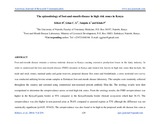| dc.contributor.author | Kibore, B | |
| dc.contributor.author | Gitao, CG | |
| dc.contributor.author | Sangula, A | |
| dc.contributor.author | Kitala, P | |
| dc.date.accessioned | 2015-02-05T13:00:41Z | |
| dc.date.available | 2015-02-05T13:00:41Z | |
| dc.date.issued | 2014 | |
| dc.identifier.citation | Kibore B, Gitao C. G, Sangula A and Kitala P (2014). The epizootiology of foot - and - mouth disease in high risk zones in Kenya. American Journal of Research Communication, 2(9), pp. 129-154 | en_US |
| dc.identifier.uri | http://www.usa-journals.com/wp-content/uploads/2014/09/Kibore_Vol29.pdf | |
| dc.identifier.uri | http://hdl.handle.net/11295/80180 | |
| dc.description.abstract | Foot
-
and
-
mouth disease remains a serious endemic disease in Kenya causing extensive production
losses in
the dairy industry.
I
n
order to
understand
the
foot
-
and
-
mouth disease (FMD)
situation
in Kenya and related
risk factors
in
high risk zones that include;
the
trade and stock routes,
national parks and game reserves, proposed disease free zones and borderlan
ds;
a
cross sectional
sero
-
survey
was conducted
utilizing
bovine
serum samples at
Embakasi
foot
-
and
-
mouth disease
laboratory.
The
samples were
randomly collected
throughout the country and
screened using commercial non
-
structural protein antibody
Elisa kit
.
The serology results were then
extrapolated to determine the seroprevalence across several high risk zones.
From the serology results,
the
FMD
seroprevalence was
higher
in
the
Kenya/Uganda border at 95%
compared to the Kenya/Somalia border (Somali ecosys
tem) which had 38.1%.
The
seroprevalence
was also higher in non
-
pastoral
areas at 58.6% compared to pastoral regions
at 53%
although the difference was not
statistically significant (p>0.05, 95%CI)
.
The seroprevalence was
also found to be high in
the propo
sed north rift
disease free zone at 97.5% as well as areas bordering the Mt. Elgon national park
at 100%. Similarly, t
he Turkana/Pokot/Trans Nzoia/ Uasin
Gishu/Nakuru/Nairobi stock route in the northern corridor
was
also
found to have high F
MD seroprevalen
ce at 80.5%.
The study was
carried out in order to assist in policy formulation and to help county governments understand the transboundary
and trans
-
county
nature of the foot
-
and
-
mouth disease. | en_US |
| dc.language.iso | en | en_US |
| dc.publisher | University of Nairobi | en_US |
| dc.subject | Foot - and - mouth disease, stock route, national parks , border lands, seroprevalenc | en_US |
| dc.title | The epizootiology of foot - and - mouth disease in high risk zones in Kenya | en_US |
| dc.type | Article | en_US |
| dc.type.material | en_US | en_US |

